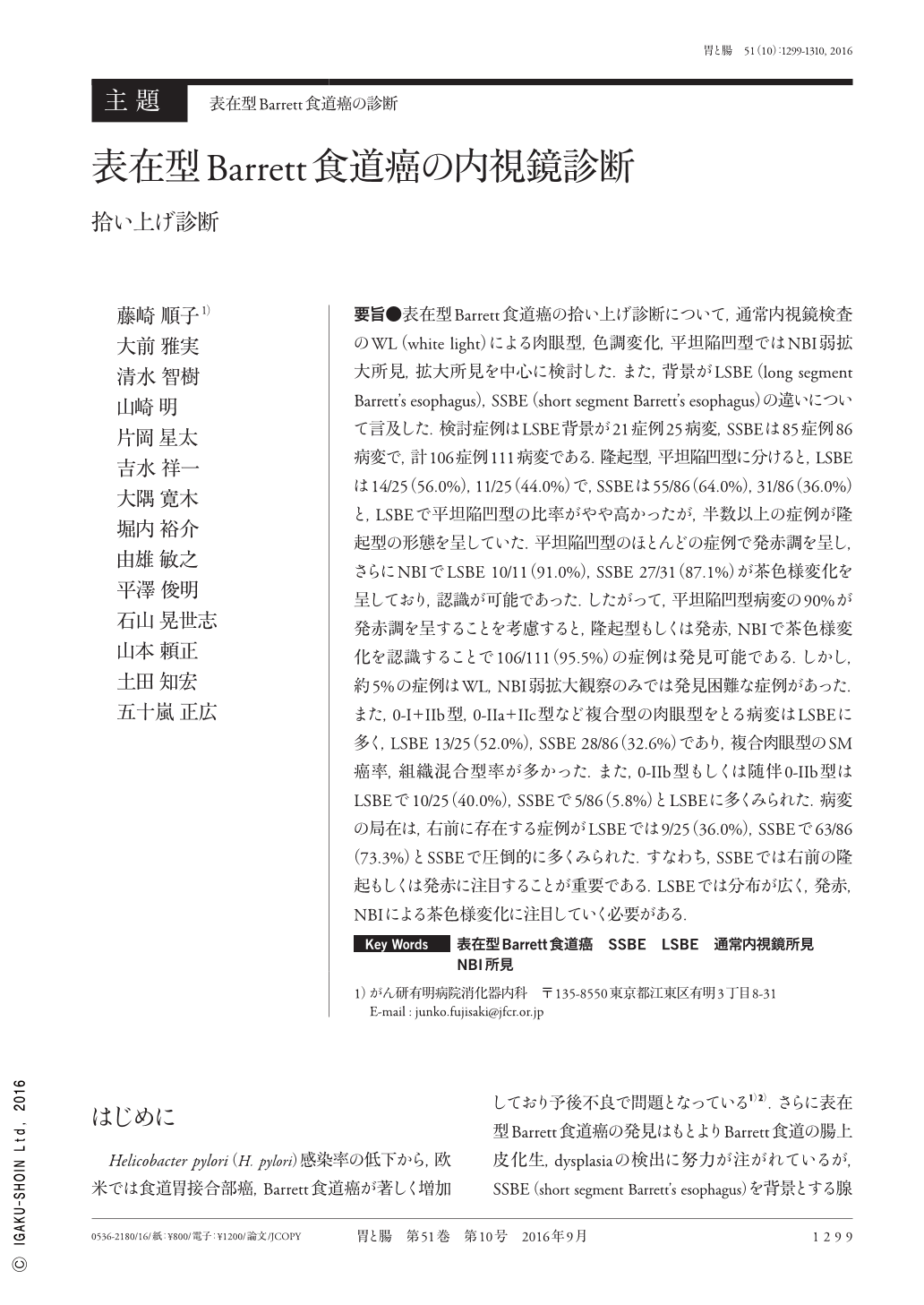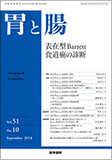Japanese
English
- 有料閲覧
- Abstract 文献概要
- 1ページ目 Look Inside
- 参考文献 Reference
- サイト内被引用 Cited by
要旨●表在型Barrett食道癌の拾い上げ診断について,通常内視鏡検査のWL(white light)による肉眼型,色調変化,平坦陥凹型ではNBI弱拡大所見,拡大所見を中心に検討した.また,背景がLSBE(long segment Barrett's esophagus),SSBE(short segment Barrett's esophagus)の違いについて言及した.検討症例はLSBE背景が21症例25病変,SSBEは85症例86病変で,計106症例111病変である.隆起型,平坦陥凹型に分けると,LSBEは14/25(56.0%),11/25(44.0%)で,SSBEは55/86(64.0%),31/86(36.0%)と,LSBEで平坦陥凹型の比率がやや高かったが,半数以上の症例が隆起型の形態を呈していた.平坦陥凹型のほとんどの症例で発赤調を呈し,さらにNBIでLSBE 10/11(91.0%),SSBE 27/31(87.1%)が茶色様変化を呈しており,認識が可能であった.したがって,平坦陥凹型病変の90%が発赤調を呈することを考慮すると,隆起型もしくは発赤,NBIで茶色様変化を認識することで106/111(95.5%)の症例は発見可能である.しかし,約5%の症例はWL,NBI弱拡大観察のみでは発見困難な症例があった.また,0-I+IIb型,0-IIa+IIc型など複合型の肉眼型をとる病変はLSBEに多く,LSBE 13/25(52.0%),SSBE 28/86(32.6%)であり,複合肉眼型のSM癌率,組織混合型率が多かった.また,0-IIb型もしくは随伴0-IIb型はLSBEで10/25(40.0%),SSBEで5/86(5.8%)とLSBEに多くみられた.病変の局在は,右前に存在する症例がLSBEでは9/25(36.0%),SSBEで63/86(73.3%)とSSBEで圧倒的に多くみられた.すなわち,SSBEでは右前の隆起もしくは発赤に注目することが重要である.LSBEでは分布が広く,発赤,NBIによる茶色様変化に注目していく必要がある.
We evaluated the endoscopic findings of superficial Barrett's esophageal adenocarcinoma by WLE(white light endoscopy). A total of 111 lesions were included, comprising 25 LSBE(long-segment Barrett's esophagus)lesions in 21 cases and 86 SSBE(short-segment Barrett's esophagus)lesions in 85 cases. Elevated lesions were observed in 14 of 25(56.0%)LSBE lesions and 55 of 86(64.0%)SSBE lesions. Regarding lesion color and type, 10 of 11(91.0%)LSBE lesions and 27 of 31(87.1%)SSBE lesions were erythematous. Further, 106 of 111(95.5%)lesions were detected to be elevated or erythematous by WLE. Regarding macroscopic type, complex-type lesions(i.e., type I+IIb, IIa+IIc, etc.)were observed in 13 of 25(52.0%)LSBE lesions and 28 of 86(32.6%)SSBE lesions. Type IIb or IIb lesions were observed in 10 of 25(40.0%)LSBE lesions and 5 of 86(5.8%)SSBE lesions. Regarding location, an upper-right location was observed in 9 of 25(36.0%)LSBE lesions and 63 of 86(73.3%)SSBE lesions. SSBE lesions were predominantly elevated, erythematous, and located in the upper-right region, whereas approximately 40% of LSBE lesions were located in the right-upper region and were more likely to accompanied by type IIb or IIb lesions.

Copyright © 2016, Igaku-Shoin Ltd. All rights reserved.


